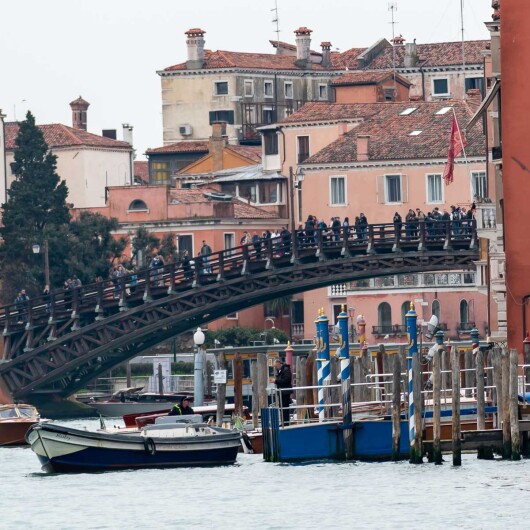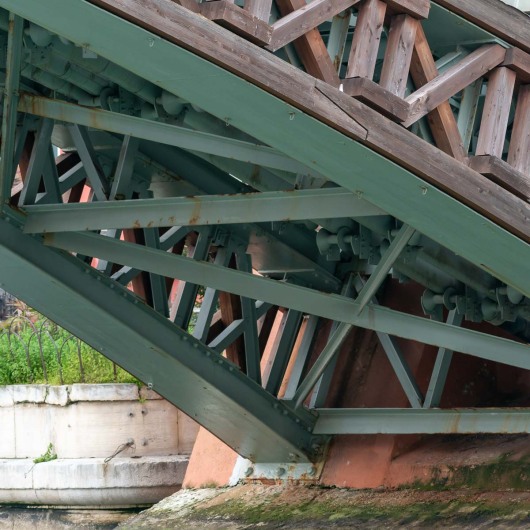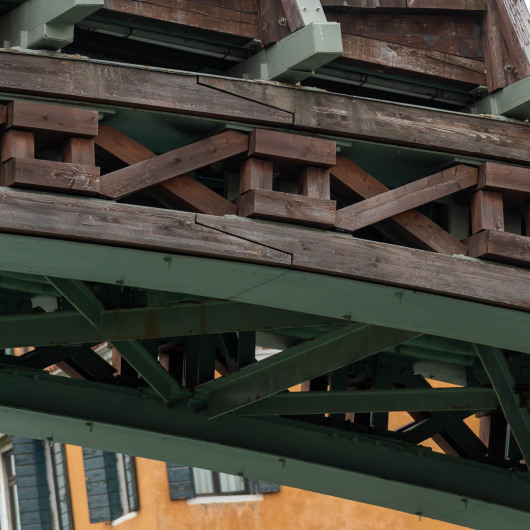Ponte dell'Accademia
Where Venice Breathes Over the Grand Canal
Venice’s Wooden Wonder
To accommodate expanding people, engineer Eugenio Miozzi's wooden bridge replaced the 1933 iron bridge in 1985. It is the only wooden bridge across the Grand Canal that connects the Accademia Gallery and the Peggy Guggenheim Collection.
Its strategic location and distinct nature distinguish it from the stone Rialto and modern Scalzi, providing an unparalleled view of Venice.
Bridge Between Two Worlds
The Ponte dell'Accademia connects Venice's Dorsoduro and San Marco neighborhoods, crossing the Grand Canal near the Santa Maria della Salute Basilica.
The west end meets the Zattere promenade, while the east end goes to the Accademia Gallery. The Accademia vaporetto stop (Lines 1, 2, and N) is a short walk away, as is St. Mark's Square.
From Gondolas to Grandeur
The Ponte dell'Accademia was created out of need and has evolved through argument. Before its construction, inhabitants traveled on traghetti gondolas. A temporary wooden bridge was erected in 1932 for Biennale visitors and immediately became needed. The bridge became permanent in 1933 when the Accademia Gallery relocated to the old Scuola della Carità, confirming its role as a vital Grand Canal crossing.
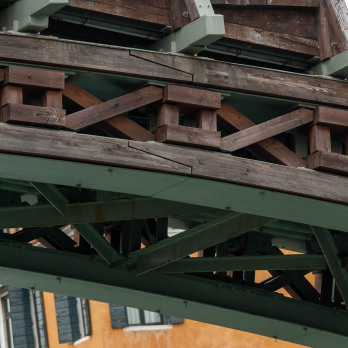
Venice’s Living Canvas
The Ponte dell'Accademia is the only wooden bridge over the Grand Canal, with a warm, intimate feel that sets it apart from its stone contemporaries.
Its true beauty is in the view: a sweeping, cinematic vision of the Grand Canal reaching beyond Santa Maria della Salute, Punta della Dogana, and San Giorgio Maggiore, transforming the bridge into a stage for Venice's daily aquatic play.
Golden Hours in Venice
For a truly wonderful experience at the Ponte dell'Accademia, come early in the morning (6:00-8:30 AM) or after 8:00 PM. At dawn, Venice moves quietly in the golden light; at sunset, the canal glows with romance. These tranquil hours display the bridge's full attractiveness, as opposed to the congested daytime rush (10:00 AM-4:00 PM), when heat and tourists drown out the serenity.
Beyond the Bridge Bliss
The Fondamenta delle Zattere provides a picturesque promenade with canal views, pleasant cafés, and local stores facing Giudecca. Visit the magnificent Baroque Church of Santa Maria della Salute. Dorsoduro is surrounded by tranquil canals, hidden campos like as Santa Margherita, and traditional bacari offering cicchetti (Venetian tapas), making it an ideal region to explore beyond the main attractions.
Cross with Conscious Care
Crossing the Ponte dell'Accademia needs awareness. Walk on the right, avoid abrupt stops, and wear non-slip shoes because the wooden surface can be slippery. Do not lean heavily on railings.
Most essential, put down your phone.
Venice is best experienced through your senses. Respect the inhabitants who utilize this bridge every day—it's more than just a photo opportunity; it's a lifeline for the community.
Art Awaits Nearby
The Ponte dell'Accademia is located in a culturally rich area and provides convenient access to two significant art landmarks. To the west is the Galleria dell'Accademia, which has masterpieces by Titian, Tintoretto, and Bellini.
The Peggy Guggenheim Collection, located just east along the picturesque Zattere promenade, houses notable modern paintings by Picasso, Pollock, Magritte, and others.
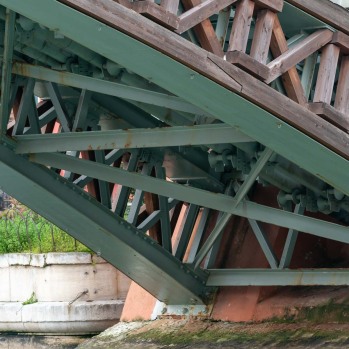
Whispers Beneath the Planks
The bridge, while newer than Venice's ancient attractions, has its own share of folklore. Locals speculate about Roman remnants beneath its foundations and criticize the 1985 wooden renovation.
Some claim to have discovered 18th-century coins or letters during the destruction of the iron bridge, but this has not been proved. More than a myth, its story embodies modern Venice: change, debate, and, a return to peace.
Venice’s Timeless Vantage
Its artistic fame stems from the breathtaking views it provides, not from the bridge itself. This unique vantage point has inspired innumerable paintings, pictures, & postcards depicting the Grand Canal heading toward Santa Maria della Salute. Since the nineteenth century, artists, particularly those of the Macchiaioli movement, have captured this unique view, establishing it as an eternal muse in Venice's art history.
Nightfall’s Venetian Magic
At night, the it provides a magical, calm respite from the daytime bustle. Softly illuminated palazzi, incandescent sites such as the Salute, and shimmering water reflections contribute to a romantic mood. The city's sounds range from soft lapping waves and distant music. Clear nights allow for stargazing, making late visits an opportunity to appreciate Venice's wonderful midnight allure before exploring local cicchetti bars.
Venice’s Cinematic Icon
Though rarely a direct filming location, the Ponte dell’Accademia’s view has become a cinematic symbol of Venice. Its sweeping Grand Canal panorama, highlighted in Nicolas Roeg’s Don’t Look Now (1973), sets an evocative Venetian mood. The bridge frequently appears in documentaries and travel films, serving as the quintessential visual shorthand for Venice’s timeless charm and atmosphere.
Safe Steps, Scenic Views
It welcomes most visitors but demands caution. Families with youngsters should grab hands securely owing to the open edges & crowding. Visitors who are elderly or have limited mobility may struggle with the uneven streets & modest inclines. The hardwood surface can be slick. Early mornings provide the safest & calmest experience, with rest areas available along the neighboring Zattere promenade.







